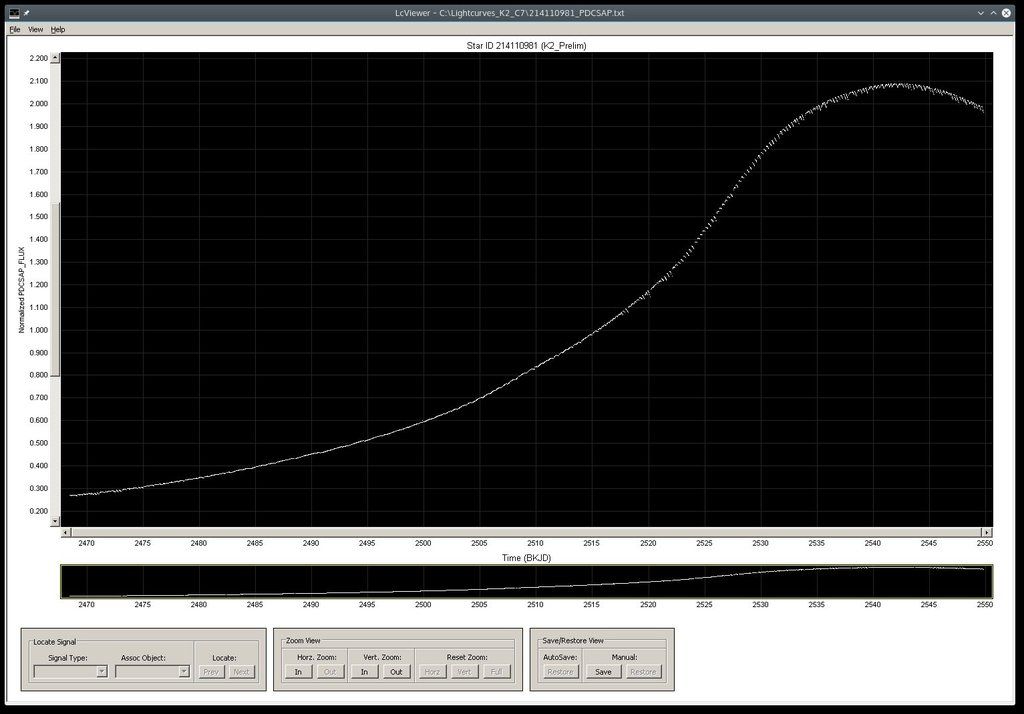New K2 mission: gravitational lensing
-
 by
ajamyajax
by
ajamyajax
"Searching for Far Out and Wandering Worlds"
NASA's Kepler mission will begin a search for planets orbiting far from their stars by using gravitational lensing.
By Jet Propulsion Laboratory, Pasadena, California
http://www.astronomy.com/news/2016/04/searching-for-far-out-and-wandering-worlds
https://exofop.ipac.caltech.edu/k2/microlensing/
Posted
-
 by
ajamyajax
by
ajamyajax
"Currently, there is about 30 stellar-mass black holes candidates known in the Milky Way. All of them, however, were discovered in binary systems with another star..."
"Microlensing by single black-holes in the Galaxy"
http://arxiv.org/pdf/1601.02830v1.pdfSeems to me that we should look for these light curve signatures in all Kepler missions, but especially K2 C7 and C9...
Posted
-
 by
arvintan
by
arvintan

Did I understand this correctly? We're looking for signatures such as these? Not sure if that's normalized flux or apparent magnitude.
Posted
-
 by
ajamyajax
in response to arvintan's comment.
by
ajamyajax
in response to arvintan's comment.
Yes as I understand microlensing from all of this, an increase in brightness as shown is what we are looking for -- be it in magnitude (what the chart uses in your posted example) or in the increased flux we should see in Kepler data.
There is a another example in this study:
Cold Neptune found with microlensing; check out the light curve on page 25 of this study:
"Spitzer Parallax of OGLE-2015-BLG-0966: A Cold Neptune in the Galactic Disk"
Street, R.A. et al.
http://arxiv.org/pdf/1508.07027v1.pdf
Also see the video in the news link above for an animated light curve example.
But what a stellar size black hole would look like to us as a companion in a binary system is anybody's guess. Maybe all the obvious gravitational influences we might expect combined(?) Interesting stuff, that's for sure. Sure hope we find them.
Posted
-
 by
zoo3hans
by
zoo3hans
Hm, maybe this star shows a microlensing effect? Or it's just an LPV.
EPIC 214110981

Posted
-
 by
Dolorous_Edd
by
Dolorous_Edd
Nope, Mira type variable
Posted
-
 by
ajamyajax
by
ajamyajax
Re 214110981: as Ivan mentioned, apparently this target is just a fascinating LP red giant and around 304 R_Sol according to Huber/NEA values.
EPIC, 2MASS, J mag, H mag, K mag, J - H, H - K, (J-H spectral type, stellar mass est) (H-K spectral type, stellar mass est)
214110981 , 2MASS J18534900-2720575 , 8.536 , 7.682 , 7.190 , 0.854 , 0.492 , ('L1V', '...') , ('M9V', 0.065)
epic_number,tm_name,ra,dec,k2_teff,k2_rad,k2_mass,k2_kepmag,k2_pmra,k2_pmdec,k2_dist
214110981,2MASS J18534900-2720575,283.454209,-27.349321,2706.00,304.18,1.07,8.536,-13.400,-4.100,Listed as V* OR Sgr -- Variable Star of Mira Cet type on Simbad
And ASAS J185349-2721.0, P=247.360886d on VSXhttps://en.wikipedia.org/wiki/Mira_variable
Posted
-
 by
ajamyajax
by
ajamyajax
I haven't had a chance to look for these yet, but maybe flare or mini-DN type events that last for several days could be microlensing candidates. What do you think?
Posted
-
 by
arvintan
in response to ajamyajax's comment.
by
arvintan
in response to ajamyajax's comment.
Seems logical to me if it's just one flare/mini-DN event. Perhaps, we should consider all one-shot days-long brightening events as microlens candidates. Haven't seen a single one though in C7.
Posted
-
 by
ajamyajax
in response to arvintan's comment.
by
ajamyajax
in response to arvintan's comment.
Yeah so far, but I'm confident we will find something. Or will again, since we may have already and it just didn't get recognized as such!
For example check out the supernova light curve example from a paper I posted in Help, and you might say "I remember seeing that in K1." 😃
https://talk.planethunters.org/#/boards/BPH0000006/discussions/DPH0000hl6
Posted
-
 by
ajamyajax
by
ajamyajax
Re finding a black hole or a neutron star in the Kepler data...
And yes, looks like they have already! See this paper for more details:
"Kepler K2 Observations of Sco X-1: Orbital Modulations and Correlations with Fermi GBM and MAXI"
R. I. Hynes, B. E. Schaefer, Z. A. Baum, C.-C. Hsu, M. L. Cherry (Louisiana State University), S. Scaringi (Max Planck Institute für Extraterrestriche Physik)
http://arxiv.org/abs/1605.00546Looks like Sco X-1 is EPIC 205703810 in K2 campaign 2.
Perhaps this is useful to us for identifying other possible candidates with the fairly wide range in the change in brightness (+/- of the mean line). See chart below:
EPIC, 2MASS, J mag, H mag, K mag, J - H, H - K, (J-H spectral type, stellar mass est) (H-K spectral type, stellar mass est)
205703810 , 2MASS J16195506-1538250 , 11.907 , 11.547 , 11.147 , 0.36 , 0.4 , ('G8V', 0.94) , ('M7V', 0.098)From NEA, K2 Targets within search area:
EPIC Number RA [decimal degrees] Dec [decimal degrees] Distance [arc sec] Kepler-band [mag] Campaign Number
205703810 244.9795 -15.6403 0.16 12.437epic_number,tm_name,ra,dec,k2_teff,k2_rad,k2_mass,k2_kepmag,k2_pmra,k2_pmdec,k2_dist
205703810,2MASS J16195506-1538250,244.979460,-15.640276,8296.00,1.85,1.87,12.437,-7.100,-12.400,From VSX:
Dist. ' Name AUID Coords (J2000) Const. Var. type Period (d) Mag. range
0.00 Variable V0818 Sco 000-BBX-338 16 19 55.07 -15 38 25.0 Sco LMXB 0.787313 11.1 - 14.1 B
Other names: Sco X-1, V0818 Sco, 2MASS J16195506-1538250, UCAC 372-075011"LMXB: Low Mass X-ray Binaries. Systems where one of the components is either a black hole or a neutron star. The other, donor, component usually fills its Roche lobe and therefore transfers mass to the compact object. The donor can be a normal dwarf, a white dwarf, or an evolved star (red giant). X-rays are emitted as the mass falls onto the compact object or onto an accretion disk that's surrounding it..."
http://www.aavso.org/vsx/index.php?view=detail.top&oid=33634
Listed as V* V818 Sco -- Low Mass X-ray Binary on Simbad, Spectral type: Oev, 16 19 55.067 -15 38 25.02

Posted
-
 by
ajamyajax
by
ajamyajax
"Predictions for the Detection and Characterization of a Population of Free-Floating Planets with K2 Campaign 9"
MATTHEW T. PENNY, NICOLAS J. RATTENBURY, B. SCOTT GAUDI AND EAMONN KERINS
http://arxiv.org/pdf/1605.01059v1.pdfSee Figure2. Example of a simulated lightcurve. (Edit: looks rather short in days actually)
"Note that the y-scales and the baseline magnitudes are very different for the K2 and ground-based photometry, and that the event as seen from K2 is highly magnified but severely blended."
Posted
-
 by
ajamyajax
by
ajamyajax
Re KIC 11769210 as an example: these could be natural outbursts in my opinion, but just thought it worth mentioning how close these two events appear to be to what we looking for regarding microlensing here.
https://oldtalk.planethunters.org/objects/APHE2003cc4/discussions/DPH101z5kv?page=2
Posted
-
 by
ajamyajax
by
ajamyajax
The C9 field looks extraordinarily busy and bright (take a look at any target in Aladin Lite and you will see what I mean). But perhaps here are a few more microlensing examples of what we might look for, as illustrated in this recent paper:
"The First Circumbinary Planet Found by Microlensing: OGLE-2007-BLG-349L(AB)c"
http://arxiv.org/abs/1609.06720(news article on the above)
"Microlensing reveals planet around binary system"
By Allen Zeyher
http://www.astronomy.com/news/2016/10/microlensing-reveals-planet-around-binary-system
Posted
-
 by
ajamyajax
by
ajamyajax
"UKIRT microlensing surveys as a pathfinder for WFIRST: The detection of five highly extinguished low-|b| events"
https://arxiv.org/pdf/1610.02039v1.pdfNote the relatively low (but smooth) magnitude changes on Page 11/Fig. 2.— Light curves of the five UKIRT microlensing events.
Posted
-
 by
ajamyajax
by
ajamyajax
Re 248368829 as a microlensing candidate, and fairly typical so far anyway: while the smaller spike here looks promising, it appears to be Solar System Object '2000 XC14'.. Also the larger spike is just another Mars crossing as can be seen second in the animation.
RA/Dec 273.293333, -23.723639
K2 ephemeris for 2000 XC14 from JPL/Horizons...
Object '2000 XC14' is visible in C5 (mag 20.7..21.8; 8.5..55.9"/h; ra 122.488..140.588; dec 9.380..11.830).
Object '2000 XC14' is visible in C9 (mag 21.1..22.2; 6.3..49.5"/h; ra 264.418..282.534; dec -24.116..-21.578).Also regarding 224757434 and 248368916: the spikes at 2675.7x both appear to be Mars crossings. So other spikes in c91 EPIC LCs at this BKJD probably are also.
Credit: This research also made use of IMCCE's SkyBoT VO tool, article 2006ASPC..351..367B.



Posted
-
 by
ajamyajax
by
ajamyajax
"Astronomers discover new gas giant exoplanet"
by Tomasz Nowakowski
http://phys.org/news/2016-12-astronomers-gas-giant-alien-world.html
(Phys.org)—Using the gravitational microlensing method, an international team of astronomers has recently detected a new gas giant exoplanet three times more massive than Jupiter...
Posted
-
 by
ajamyajax
by
ajamyajax
"Microlensing study suggests most common outer planets likely Neptune-mass"
by Francis Reddy
http://phys.org/news/2016-12-microlensing-common-outer-planets-neptune-mass.html
Posted
-
 by
ajamyajax
by
ajamyajax
"'Iceball' planet discovered through microlensing"
https://phys.org/news/2017-04-iceball-planet-microlensing.html
Posted
-
 by
ajamyajax
by
ajamyajax
"Two new Saturn-mass exoplanets discovered"
by Tomasz Nowakowski
https://phys.org/news/2017-05-saturn-mass-exoplanets.html
Posted